Growing Arabica Coffee
Compendium on growing arabica coffee
Compendium on growing arabica coffee
Naturally, arabica coffee (Coffea arabica) is an understorey component of tropical forests. It is a small tree, frequently multi-stem, whose size rarely exceeds 10 m high.
 Arabica coffee appreciates shaded and cool environments. Optimal temperatures for its growth average 20 to 22°C., with extremes from 4°C to 35°C. Climates with well contrasted dry and wet seasons, either mono- or bi-modal, are suitable for its development as long as total precipitation is about 1500mm to 1800mm and that a period without rain does not exceed 2.5 months. Hence its distribution in Africa in mountainous or highlands regions is within the range of 1500 m to 2000 m elevation (as opposed to C. canephora Robusta distribution in humid, lowland areas).
Arabica coffee appreciates shaded and cool environments. Optimal temperatures for its growth average 20 to 22°C., with extremes from 4°C to 35°C. Climates with well contrasted dry and wet seasons, either mono- or bi-modal, are suitable for its development as long as total precipitation is about 1500mm to 1800mm and that a period without rain does not exceed 2.5 months. Hence its distribution in Africa in mountainous or highlands regions is within the range of 1500 m to 2000 m elevation (as opposed to C. canephora Robusta distribution in humid, lowland areas).
Like all living organisms, coffee plants need to feed, drink and breath. Once these are both qualitatively and quantitatively ensured, the plant will grow and multiply in such a way that profitable crop production is obtained.
Aiming for this goal, farmers and scientists have designed a set of practices to ensure good health and vigor of the coffee plant. These are detailed in the following pages, addressing the various stages of coffee cultivation.
Coffee nurseries are organized to operate in two successive steps: plantlet production from germinated seeds and seedling production from plantlets.
For these purposes, the nursery includes:
 |
 |
 |
Where to build the nursery?
| on flat ground | not exposed to strong winds |
| on non-floodable land | near a permanent water point |
| protected from land erosion | easy to access, and close to houses |
How big should it be?
The nursery should be designed to match your needs in seedlings. These of course depend on the size of your plot and the density you want to plant. But it also depends on various losses or accidents that may occur during the seedling production process.
Calculate the number of seeds to buy:
| seed-beds | transplanting | Nursery beds | Total | |
| Average losses | 20% | 10% | 10% | 35% |
| For one hectare (2666 coffee trees), you need 4.100 seeds. This corresponds to: |
| Surface of seed-beds (sown at 2 cm × 5 cm) = 4.1 m² |
| Surface of seedling-beds (1 bag = 0.015 m²) = 50.0 m² |
Prepare the nursery design.
 |
The seed-bed and nursery-bed width should be in the range of 120 cm to 140 cm. The path between beds should be about 60 cm width. Seed-bed and nursery-bed should be built above ground level (some 20 to 25 cm) to facilitate the drainage of excess water. |
Shade is an important characteristic of the nursery. It should be close to 50% at the initial stage of the production, to be further reduced to 30% before seedling transplantation.
 |
 |
Soil preparation:
Good nursery soil should be loose and rich in organic matter.
This can be achieved by mixing:
To test the quality of the mixture, roll in your hand a sample of this soil, moistened, but not too wet.
| A good mixture should be able to roll and keep its shape but the mud “stick” should break if bent. |  |
| If it does not break, then the soil contains too much clay. |  |
| If it crumbles before you can roll it, it contains too much sand. |  |
|
Draw furrows with a ruler every 5 cm across the width of the beds. Place the seeds, flat side down, every 2 cm at the bottom of the furrows to a depth of 1 cm. After sowing, cover the seeds with a layer of 1 cm of clean sand then water and cover with straw. |
 |
|
The seedlings are protected by straw, that we keep for three weeks. Then they grow for another two weeks till they reach the "soldier" stage. |
 |
|
Water according to the frequency of rains and ambient temperature. Inspect the seed-beds daily and meticulously. |
Remove mulch when seed emergence begins: 3 to 4 weeks. Perform pest and disease control depending on their incidences |
Bag preparation
 |
 |
Seeling transfer
 |
Select the best seedlings to be transfered Seedlings to be transplanted to bags should be well developed and without any signs of anomaly. Importantly, the main root should be well structured, showing no sign of curving or division, which could hamper the correct growth of the future plant. |
 |
|
Type of seedlings to be discarded: bent or ramified root.
 |
 |
Once allowed to grow in bags, during a period that may last as long as 8 to 9 months, it is necessary to ensure sufficient fertilization and water supply. It is also necessary to ensure correct weeding and protection against pests and diseases.
When seedlings grow, their need for light will increase. Ensure there is correct spacing between bags, allowing the plants to grow without competition for light.
 |
 |
 |
When seedlings reach the stage of 6 to 8 pairs of fully expanded leaves, they are ready for planting. At that stage, 2 weeks before transfer to the field, the nursery shade should be slightly reduced from 50% to 30%, this is for the seedlings to progressively accommodate the field conditions. |
Careful seedling selection is required to transfer to the field only the individuals with the best chance to grow normally and to have full capacity for mineral and water absorption. Practically this means that any detected default on the seedling root system should lead to non-selection. Most common root problems that you will detect include bent roots, multiple roots, twisted roots.
Most frequent seedling production problems:
| Over-grown seedlings due to an overcrowded nursery bed: seedlings are too close to each other |  |
| Stunted seedling due to the use of recycled old bags. |  |
Among other activities, coffee cultivation requires special care in two domains: shade management and soil protection. Although these have to be considered during the entire cycle of coffee production, they have to receive attention even before planting, to best prepare for the installation of your crop and its further development.
After having finalized the general setup of the plot, it will be time to prepare for the seedling transfer from the nursery to the field. Planting design should be finalized (density, tree position) and planting holes should be prepared at least one month before planting.
Naturally, coffee is adapted to a forest shaded environment. Under reduced light conditions, coffee plants remain healthy and can frequently reach the age of 50 years. But in such conditions, its growth is slow and fruiting is limited, quite not suitable for profitable coffee farming.
To compensate for this, opening or clearing the canopy over the coffee plot is usually done to stimulate plant growth and cherry production. However, in doing so one risks over-stimulating plant development leading to its progressive exhaustion, production drop and, ultimately, plant death.
To avoid this situation, it is highly recommended to maintain some shade over the coffee plot, to protect the plant against unbalanced growth conditions. For an acceptable trade-off between production and vigor, intermediate shade levels of about 30% are recommended (e.g. that the full-sun light is reduced by 30%). Then, the plant yield will be kept at a profitable level, while ensuring longevity of the crop.
Shade management is an important component of agroforestry which benefits producers in various domains:
 |
|
Being grown in highlands or mountainous regions, Arabica coffee plots are generally installed on sloped areas, which are exposed to heavy rains and water run-off. Ignoring this will ultimately lead to more or less important and rapid damages to the plot such as flooding, soil erosion and mineral depletion and eventually land-slides. Therefore, it is recommended to anticipate the problems before they occur and to implement solutions before the situation becomes too complex or impossible to solve.
When the slope is greater than 5%, soil conservation measures have to be taken. They are mostly derived from contour cultivation practices to reduce the speed and amount of run-off.
 |
 |
 |
 |
These include various construction techniques such as inter-row ridges, silt pits, drains and waterways. When the slope is steeper than 25%, terracing is a common and necessary practice to prevent erosion. Stabilization of all these constructions is generally required. To do so, planting trees or installing perennial grass with a deep root system have been proven efficient.
3. Preparing for planting
Once the plot is organized, it is time to prepare for planting. The position of each tree has to be located in the field as precisely as possible, this is to make sure that the desired tree density isobtained for the expected productivity.
For a planting density = 2,666 coffee/ha
Planting holes have to be dug well in advance for optimal soil preparation. This is an important but tedious work as the holes are big in size (60x60x60cm) and the soil has to be moved at least twice (removal, mixing with organic compost and manure, returned into the hole) before the holes can receive the seedlings. Only this will provide good conditions for the seedlings to promptly recover from the transfer stress.
 |
 |
 |
| 1. Dig holes of 60 cm × 60 cm | 2. Put the top soil at the bottom of the hole | 3. Then mix the bottom soil with compost and put it on top. |
Finally, you are ready to transfer the seedlings to your farm.
Seedlings need to be healthy and vigorous and should have at least 4 to 8 developed pairs of leaves. Individuals with roots defects (bent or divided/multiple) should not be selected as it could hamper the correct growth of the future plant.
 |
 |
 |
Before the seedling is planted, the bottom of the bag should be cut (to free the pivot root) before the bag is removed; once this is done, the seedling can be carefully planted, making sure that the collar of the stem is at the level of the soil.
2-3 weeks after the rain onset:
|
Cut the bottom of the bag,
|
Remove the plastic bag
|
|
Place the coffee with the collar at ground level
|
Firmly compact the soil around the plant. No air pocket!
|
 |
Finally, protect the young plant from light and drought.
|
 |
Avoid to deep planting:
|
The following pages are meant to guide you to ensure harmonious growth of your crop for a long lasting production period of about 15 to 20 years. The chapter is organized into 5 sections covering two production cycles, each of 7 to 8 years, between 2 planting activities:
|
Planting |
Production |
Rejuvenation/stumping |
Production |
Replacement |
|
Cycle 1 |
|
|
Cycle 2 |
|
Field maintenance: During the first year after planting, if planting has been well prepared, the field will not require special treatment. Good care of the crop will however obligate you to remove the weeds that may have developed and to make sure that the installed mulch is kept in place.
Crop monitoring: Some of the seedlings may not survive the planting process. Control the seedlings development and prepare for replacement, either during the current rainy season, if it is not too late, or for the next one.
 |
|
Crop monitoring: Some of the seedlings may not survive the planting process. Control the seedling development and prepare for replacement either during the current rainy season, if it is not too late, or for the next one.
Multi-stem initiation: Three months after planting, when seedlings are well established, you will have to implement an important operation aiming at shaping the plant in a multi-stem architecture. Usually, not more than 3 stems are kept per plant; they are obtained after bending the current single shoot, thus inducing the growth of vertical suckers. Finally, the head of the main stem is cut-off and extra suckers are removed.

Weeds are detrimental to your crop because they compete with it. They divert a large quantity of nutrients and water that won't be available for the coffee anymore, resulting in a lower than expected coffee productivity.
 |
 |
Weed control can be achieved in several ways. Ploughing is of course one of them; other ways include practices that will reduce weed growth such as shading the plot (grasses usually don't grow well under reduced light conditions), or covering the inter-row ground by mulching or inter-cropping.
The most important damaging weeds are:
Weed control is also frequently achieved through herbicide application; although efficient, these are costly and their impact on the environment and human communities can be detrimental. Hence their use is banned by many certification schemes aiming to improve quality.
|
Why |
When |
Manual weeding |
|
To reduce:
|
|
|
Mulching is of great importance to keep the plants healthy and vigorous as it greatly contributes to the feeding of the plant. Applied after the rainy season, it should protect the plot from soil desiccation without generating extremely high humidity around the coffee plot.
 |
Mulch decomposition improves soil fertility (structure and chemical). |
 |
Reduces weed competition. Fights against erosion. |
 |
Retains water and improves its penetration in the topsoil. Decreases evaporation and pPreserves water (soil humidity) during dry months. |
 |
Reduces variations of soil temperature |
Inconvenient: It requires very high amounts of fresh weeds: More than 40 tons / hectare / year
What mulching materials? Mulching can be achieved by using all sorts of organic material as long as ground coverage is obtained.
 |
 |
 |
When to install mulch? The best period to mulch is the end of the rainy season (April-May) in order to have good soil protection in the dry season.
 |
Clear coffee tree foot to avoid rot. |
Alternatives to protect the soil exist, including the use of shade trees, inter-cropping practices and, when possible, increasing the coffee crop density.
| Shade trees or intercrops that provide biomass (e.g. legumes) | Intercropping in the spaces between coffee tree lines (preferably legumes providing a lot of biomass) | Better space management: Change the planting distances to allow intercropping or a bunch of bananas: Double (or triple) lines of coffee trees, at closer distances |
 |
 |
 |
Coffee growth is continuous, but the productive part of a branch is limited to its extremity.
The tips of the stems and branches bear leaves

Then the flowers (fruits) appear at each node.
In natural conditions, coffee will accumulate sterile branches, thus reducing fruit production.
Furthermore, aging coffee has a productivity that progressively declines, to become minimal (and not profitable) after 7 to 8 years of growth.
If one wants to obtain an optimal cherry production, coffee trees have to be regularly re-shaped; this is the purpose of pruning. It is an important practice that can increase productivity to as much as 30%.
There are four different types of pruning, according to the problem that is being addressed: Formation, Desuckering, Production, Rejuvenation
 |
Formation: is implemented to give the plant an "architecture" that will increase production while maintaining a manageable size to facilitate harvesting. A very common and efficient type is the 3/4 stems system, which is generated after planting. |
 |
Desuckering: Done every 2 months to remove any non-necessary stem overgrowth and then avoid overproduction of wood which would be detrimental to fruit production. |
Production: Removal of old and unproductive branches (primaries) that are unnecessary, dead or sick or too many.
Done annually, after the main harvest, pruning is a critical factor in guaranteeing good yields.
 |
|
Pruning allows you to manage the architecture of the coffee tree to properly balance the vegetative- cherry ratio.
| Good pruning, with few productive stems | Poor pruning, with too many non-productive stems and branches |
 |
 |
Rejuvenation pruning; When pruning is no longer efficient to give the tree a productive structure, it is time to stump it to induce the formation of new and more vigorous stems. This is usually done after a production cycle of 7 to 8 years, to minimize the impact of the loss of production (when trees are stumped) over a period of time of 15 to 18 years, equivalent to 2 production cycles.
To prepare the rejuvenation:
 |
Some of the primary branches from the inside are cut to force the stems to bend. This brings more light to:
|
Two methods are possible to remove the old stems and stimulate the growth of young stems.
|
Blank (without lung-branch) Suitable for young coffee trees |
 |
| With lung-branch or weak or old coffee trees |
|
 |
 |
| Select well distributed suckers | A pruning saw is the best tool |
For healthy development, coffee requires specific supplies in nutriments. These are the minerals. They are many and originate from the rocks that constitute the soil of your farm.
Coffee has important needs in six of them, i.e., Nitrogen (N), Phosphorous (P), Potassium (K), Calcium (Ca), Magnesium (Mg) and Zinc (Zn). Needs for other minerals such as Sulfur (S), Iron (Fe), Manganese (Mn), Copper (Cu), Zinc (Zn), Molybdenum (Mo) and Boron (Bo) are less, but still critical for the plant growth.
Nitrogen (N) is critical for the constitution and development of all plant vegetative organs (leaves, stems, roots);
 |
 |
|
Nitrogen is essential for the vegetative growth of the coffee tree. It is involved in all of the plant formation processes. It represents almost 4% of the dry matter |
The Nitrogen requirements are always necessary and profitable for the coffee tree. But it should not be overdosed, otherwise it will cause too long branches and reduce flowering |
Phosphorous (P) plays an important role in root development, photosynthesis and flowers development;
 |
 |
| Too much Phosphorous => Zinc deficiency, because they are antagonists. |
Potassium (K) is responsible for good development and quality of cherries;
 |
 |
| Potassium is an antagonist of Nitrogen; too much potassium limits the production of coffee beans. | Potassium (K) is an antagonist of Calcium (Ca) and Magnesium (Mg); soil rich in potassium = deficiencies in Calcium and Magnesium. |
Calcium (Ca) is involved in bud and flowers development. It is also involved in the photosynthesis process;
 |
| In case of high soil acidity, calcium is necessary to neutralize the pH |
Magnesium (Mg) is required for good photosynthesis;
 |
 |
| Magnesium deficiency symptoms appear when there is too much potassium | The balance between Potassium - Calcium - Magnesium is very important for the coffee tree. |
Zinc (Zn) is involved in the plant physiology regulation and hormonal synthesis.
 |
 |
| Zinc is: Antagonist of Potassium and Phosphorous (Avoid excess of P2O5 fertiliser) |
Commonly found in soils that are:
|
Minerals solutions in soil water are captured and assimilated by the small and tiny roots of coffee; they are further distributed upward to the plant using the vessels of the stems and branches.
Mineral availability is largely controlled by the soil acidity. In acidic soil (pH<5), most of the minerals lose their ability to dissolve in water; they become less accessible to the roots and the plant becomes deficient, not well fed. An efficient mineral absorption by the roots is obtained in neutral or slightly acidic soils, whose pH is between 6 to 8.

Hence, to ensure permanent and adequate nutrition to the plant you need to:
|
When to apply: The fertilizer applications are split over two periods: Nitrogen, Phosphorous, Potassium (N,P,K): short rainy season (to support flowering) Nitrogen only: Long rainy season (to ensure production and avoid die-back) |
Where to apply: Where the roots of coffee trees are found: In the crowns under the cover of the branches of the coffee |
 |
 |
Arabica is the host of various pests and diseases that can damage all plant organs: branches and stem, leaves, roots and fruit.
Damages to fruits leads to direct loss in production either because the bean won’t develop or will lose marketable quality during the maturation process (being broken, rotten or spoiled).
Attacks on other organs will induce indirect losses in production; they weaken the plant by reducing its capacity to either absorb light (leaf and branch damages) or nutrients (root attacks reduce water and mineral uptakes). In both cases, the plant will have reduced capacity to ensure proper fruit development.
Pests and diseases are therefore an important issue to be seriously addressed if one wants limited impact and minimal production and income losses.
Pest and disease development is mostly controlled by specific weather conditions such as temperature, rainfall, soil and air humidity. But other factors intervene also to favor or reduce their dissemination and multiplication. Quite frequently, a healthy and vigorous plant will better tolerate or resist attacks of a parasite; specific farm environment conditions (light availability, air circulation, etc.) may either fasten or slow down the development of epidemics. Therefore the importance of well managed farming practices as efficient measures to prevent high infestation levels of the crop is recommended.
In these pages, we will emphasize the role of farming practices as options for pests and diseases control, as they are costless (in money) and do not require the use of chemicals.
During an epidemic event, two distincts stages are generally noticed: (i) a phase of installation, when the pathogen first arrives on the crop. At that stage, the number of attacks is small and infestation spots are more or less scattered; (ii) a phase of multiplication , during which the pathogen multiplies and disseminates. Infestations spots become abundant, numerous, and widespread on the farm.
It is a general rule in epidemic control that intervention can be efficient only if applied during the early stage of installation of the pathogen, when its prevalence is still small. Once this phase is over, infestation spots will be too numerous and any control measures will rapidly lose efficiency.
Therefore vigilance and quick reaction is the correct attitude to avoid important production impact.
In the next pages, we present factsheets about the main pest and disease that may be detected in your area on Arabica coffee.
Descriptions of the symptoms are given to help you identify the problem (diagnostic), understand the cause of its development and initiate proper control measures. Preference is given to Best Agronomic Practices and farm management measures as control options prior to chemical options. Also mentioned (when available) the latter are considered less cost effective, with negative impact on human and environmental health. They might also be a risk as their implementation may conflict with the certification standards that apply to your production (such as Organic Certification).
In Rwenzori area, most frequent problems are generated by insects such as borers or grazers of various organs such as BTB (Black Twig Borer), CBB (Coffee Berry Borer), WSB (White Stem Borer) and Antestia bug, or by fungus such as CLR (Coffee Leaf Rust) and CBD (Coffee Berry Disease). Less frequent problems are not detailed in this review but can be found in various publications:
https://apsjournals.apsnet.org/doi/book/10.1094/9780890544723,
https://www.apsnet.org/edcenter/resources/commonnames/Pages/Coffee.aspx
https://www.plantwise.org/FullTextPDF/2013/20137804172.pdf
General description:
The BTB is a small, (1 to 2 mm in length) shiny black insect of oval shape. Its Latin name is Xylosandrus compactus; it is a Coleoptera of the Curculionidae family. The beetle spends much of its life inside the coffee branch and is usually only seen when the branch is broken open. In Uganda, BTB mostly attacks Coffea canephora (Robusta) but can also be found on C. arabica and Cocoa.
 |
 |
Illustration 1: Xylosandrus compactus; female adult (left) and larvae (right)
Symptoms:
 |
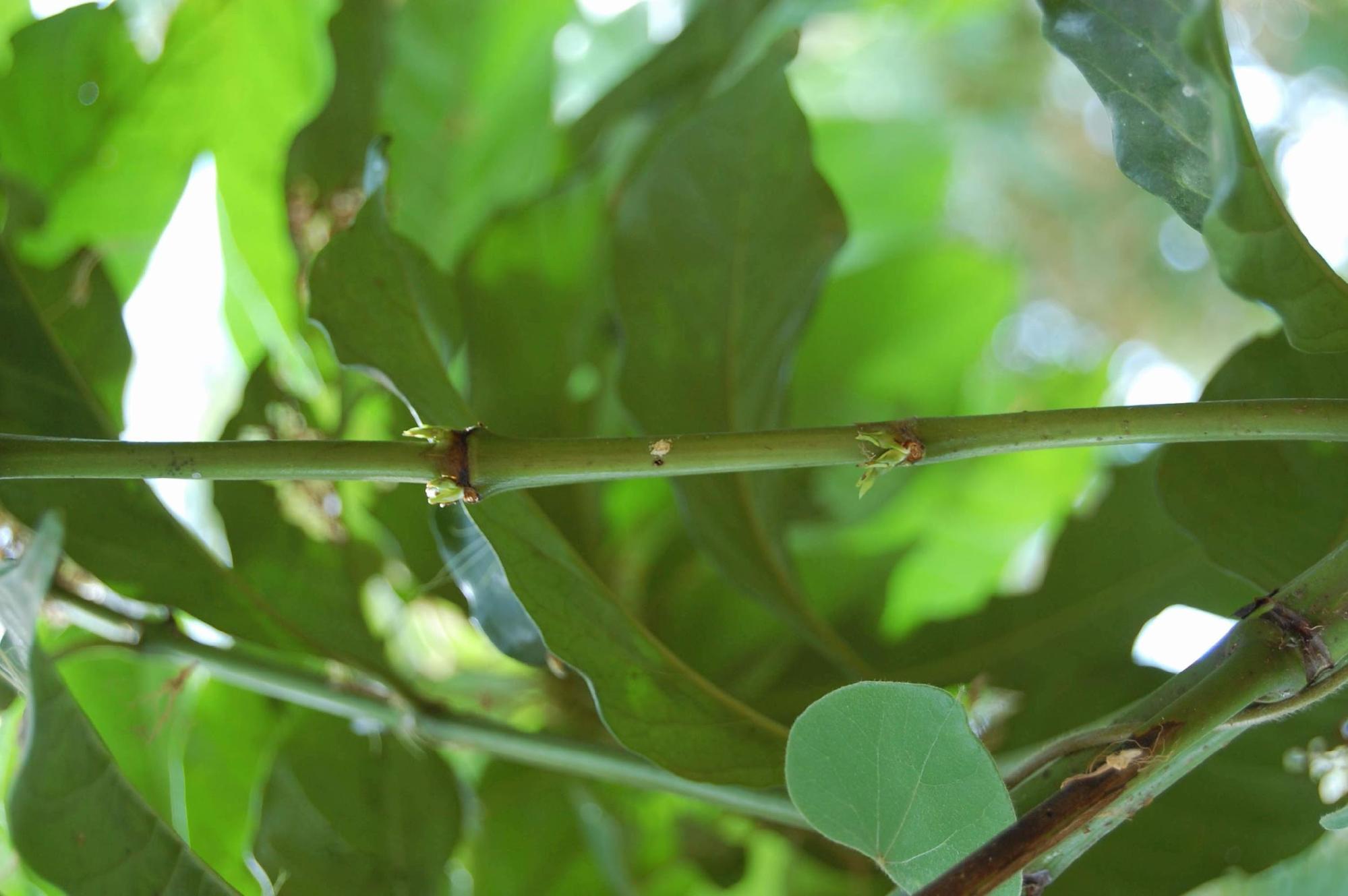 |
 |
Illustration 2: X. compactus symptoms on Robusta twigs; penetration holes (left) and twig die-back (right)
Females tunnel into the current year's twigs, leaving pin-sized entry holes. Once inside they dig through the young coffee branches causing the death of branches. One to three females are enough to kill the twig or branch. The early signs of infestation are a yellowing of the leaves on a branch. After inspection, a white or light brown pile of dust can sometimes be seen at each hole. Later signs of infestation are a blackening of the stem and leaves from the entrance hole towards the tip of the branch. Wilting of twigs and branches is usually seen within weeks of infestation.
Life cycle and environment:
The life cycle of the black twig borer is completed in about a month. Female beetles attack twigs or branches and bore in to the pith or if the twig is large, they bore into the wood. Black twig borers are capable of laying eggs without mating (parthenogenesis). After the females bore into a twig, they form a small chamber in which female will lay eggs. The eggs are laid over a period of several weeks. They hatch three to five days later. The tiny larvae feed on the fungi that grow on the walls of the brood chamber. The grubs pupate and then (if males happen to have developed) the new beetles mate before leaving the twig to infest new twigs. If the twig is small, only one female will attack it, but if it is more robust, up to 20 females will attack it. During the warm season it takes about two to three weeks from egg to adult beetles. During the rainy season, as temperatures are lower development is slower. If conditions of temperatures are too low, the adults can stay inside the damaged twigs until the next dry season.
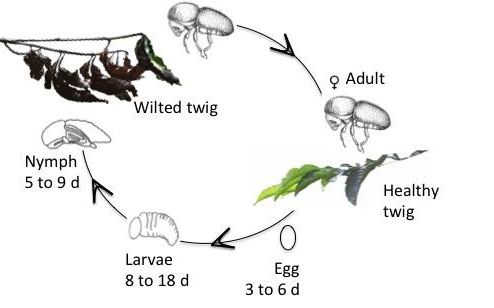
Illustration 3: Life cycle of X. compactus, or Black Twig Borer (BTB). (duration is expressed in days)
BTB Control:
Integrated pest management (IPM): it is currently the method of control advocated by many coffee research institutes, producer associations, development cooperation centres and government authorities.
IPM consist of several methods of control applied together, including:
Prevention:
Monitoring:
Direct action:
General description:
CBB is a small, dark brown to shiny black cylindric insect of about 1.7 mm in average length for the female and 1.2 mm for the male. Its latin name is Hypothenemus hampei; it is a Coleoptera of the Curculionidae family. In this species, only the female has the capacity to fly as the males have reduced membranous wings, unsuitable for flight.
CBB is found on both C. arabica and C. canephora indifferently.

Illustration 1: Hypothenemus hampei (Coffee Berry Borer); female adult
Symptoms and life cycle:
CBB only attacks only the coffee berry during the maturation process. The main symptom revealing CBB infestation is the presence of a single small black hole on the extremity of berries due to the penetration of the female. Once the berry is perforated, the female digs galleries and starts laying eggs at a rate of 2 to 4 eggs per day. However, if the seed is still soft it may wait in the fruit for it to become firm, or visit other berries. Eggs are about 0.6 mm long, and are laid in chambers chewed out of the beans, each female producing 30-50 eggs in 2-7 weeks. Eggs hatch within a week or so. After hatching, tiny, white warm-like larvae feed on the pulp and the grain in which they bore galleries. They can consume one or both seeds. The nymphal stage is attained after two more weeks of development; 4-9 additional days are needed for them to turn into an adult. After this time new females emerge; they can either fly away and colonize new fruit, or re-colonize the same cherry. The entire life cycle is about 4 weeks. There are about 10 females for every male. Males have short wings and do not fly; they remain in the berries for the 3 months of their lives. Females are fertilised a few days before they leave the berries to find other berries in which to lay their eggs although some females may remain and lay eggs in the same berry. Females live on average 150 days, much longer than the males.
 |
 |
Illustration 2: CBB penetration hole on immature berry

Illustration 3: CBB galleries on bean.
Although mostly found on coffee, CBB can attack about 50 plants species on which it can feed and reproduce (primary hosts) or feed and take refuge temporarily (secondary hosts); the levels of infestation may vary dependant on environmental factors.
Environmental variables:
The dispersal of colonizing females is closely related to the coffee development cycle itself and berries availability, dependant of the environmental conditions.
In environments with a marked alternation of one dry and one wet season, there is only one single annual harvest, which usually takes place at the beginning of the dry season. In this context, after the harvest , there is one main migration or flight period of the females coming from the residual berries abandoned on the ground or remaining on the branches. These flights are usually caused by an abrupt rise in ambient humidity, after a rainstorm for example, and allow CBB to pass from one field to another.
When the degree of ripening of the berries becomes acceptable, i.e. when the seeds are becoming hard, the CBBs colonize them. If the berries didn’t reach sufficient degree of ripening, flying individuals are unable to colonize them. In case of successful colonization, the following generations (about 4 weeks later) ensure another dispersal over short distances, from nodes to nodes and from branch to branch. Thus, every 4 weeks, a new generation will be produced throughout the ripening season.
During the harvesting period, the berries are collected in several times, carried out and then transported to the post-harvest treatment centres, whether infested or not. At the end of the harvesting period, the populations of CBB remaining in the plantations are reduced to some groups hosted by the residual berries.
In environments with a double alternation of dry and wet season, the flowering and fruiting occur over much of the year and usually result in two annual harvests of coffee. The almost permanent presence of berries contributes to the continuous infestation by the CBB. Finally, and contrary to what is observed in an environment with one clear dry season, the migration of females coming from the residual cherries is more or less continuous and migration peaks are not perceptible. Thus, CBB is present all year long, with a new generation every 4 weeks.
CBB control:
Integrated pest management (IPM): it is currently the method of control advocated by many coffee research institutes, producer associations, development cooperation centres and government authorities. The main objective is to avoid the use of chemicals and to have the most comprehensive approach, preserving the health of farmers and local populations as much as the environment in order to maintain the stability of agricultural activities as stable as possible.
IPM consist of several methods of control applied together, including:
Prevention:
Monitoring:
Direct action:

Illustration 3: Scheme 1: BROCAP® trap
Use baited traps (18/hectare) to catch adults flying after the first rains or in the inter-harvest period (when the coffee berry borer is emerging and few fruits are available). Traps should be checked every 5 days. If commercial ones are being used, replace the bait dispenser every 2 months. If using handmade trap refill after every check.
General description:
ACWSB is a typical longicorn beetle, fusiform, with an antenna longer than its body. The male size is about 25.5 mm while the female is about 27.2 mm. Sexes can be distinguished by antenna length relative to the body length which is at least two times longer for males.
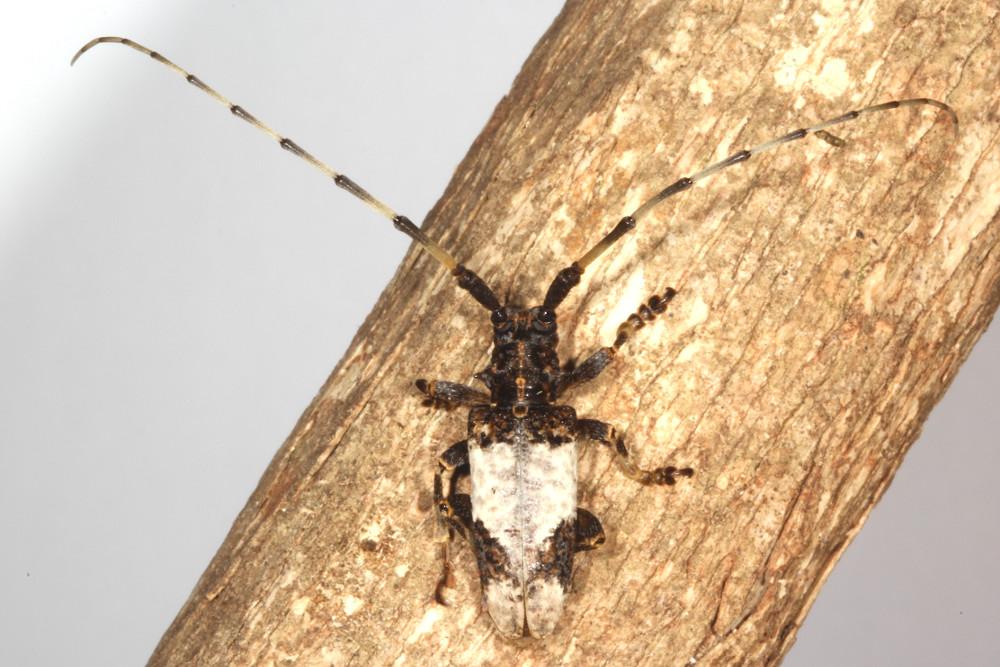
Illustration 1: Adult Monochamus leuconotus; White Stem Borer.
Apart from a whitish median and basal sector on the back, the beetles are brown. Its latin name is Monochamus leuconotus, it is a coleoptera of Cerambycidae and sub-family Lamiinae. This insect attacks only Coffea arabica.
Symptoms:
 |
 |
Illustration 2: Gallery of M. leuconotus larvae in the main stem.
The presence of ACWSB is detected on the main stem by signs of ring barking, circular holes and frass (wood shavings at the base of the plant). These are frequently associated with yellowing leaves as the result of damages to the stem. ACWSB attack leads to growth delay, wilting, dieback and reduced yields on affected plants. Although the adult's feeding activities may damage buds, shoots and stem bark, the feeding activities of the larvae on the core and lower parts of the stem is the cause of the main economic damages.
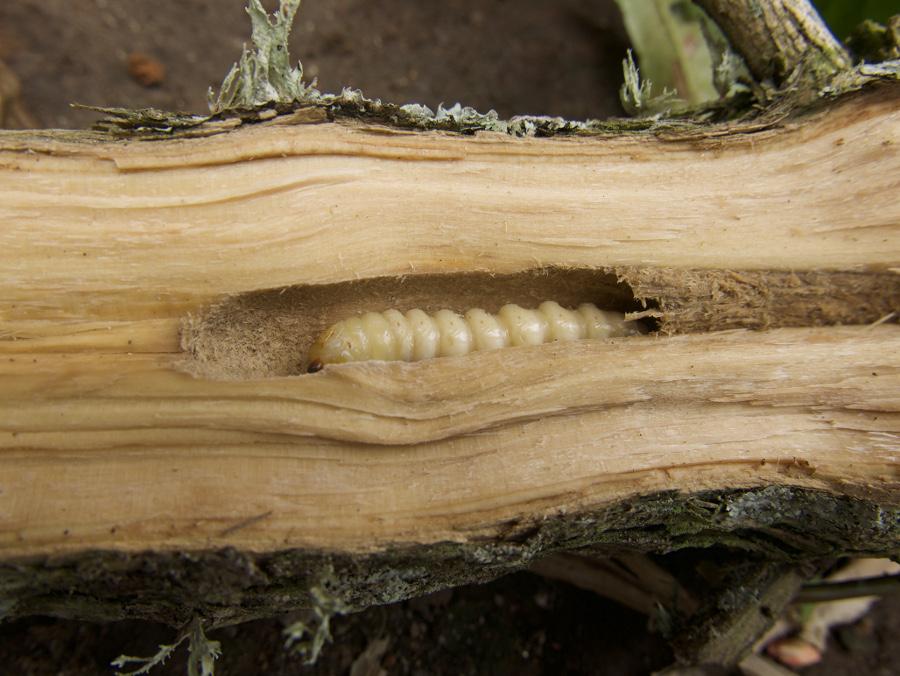 |
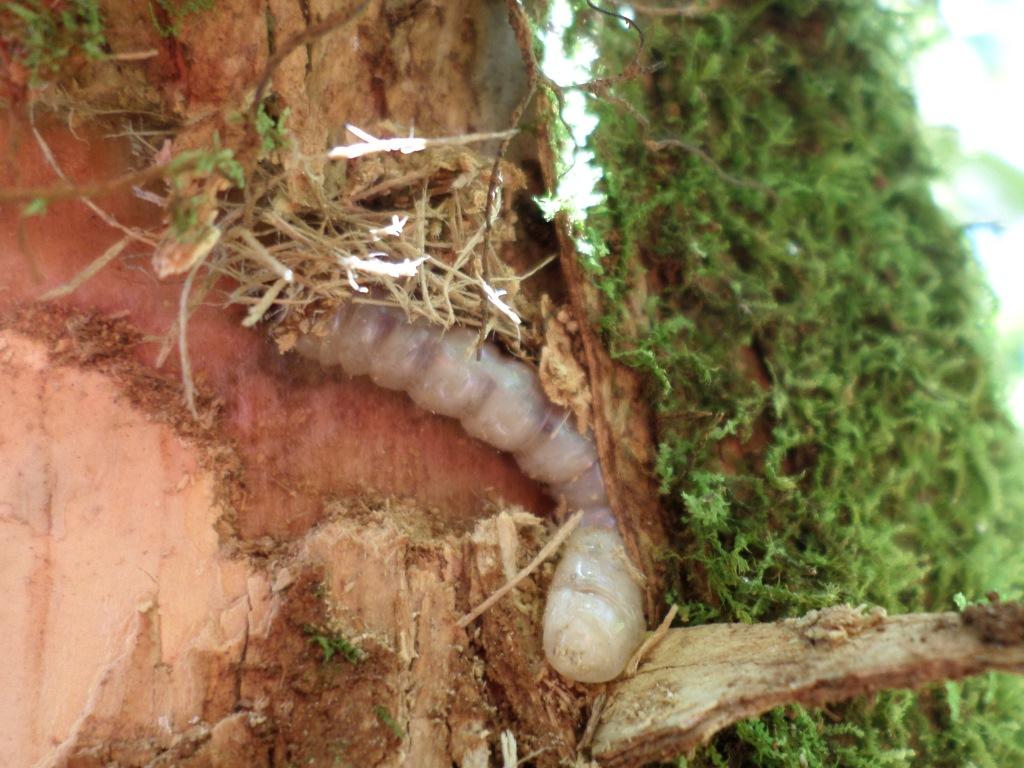 |
Illustration 3: Feeding M. leuconoteus larvae on the wood of the main stem.
Life cycle and environmental variables:
The adults lay eggs on the bark of the coffee plant and when hatched the larvae bore galleries into the bark causing ring barking and choking of the plant system with frass, which disturbs uptake of metabolites. The larval stage lasts for about 20 months, then new adults will emerge from the plant. Mean longevity of female and male beetles is about 122 and 112 days, respectively. The complete life cycle of the ACWSB can be up to two years.
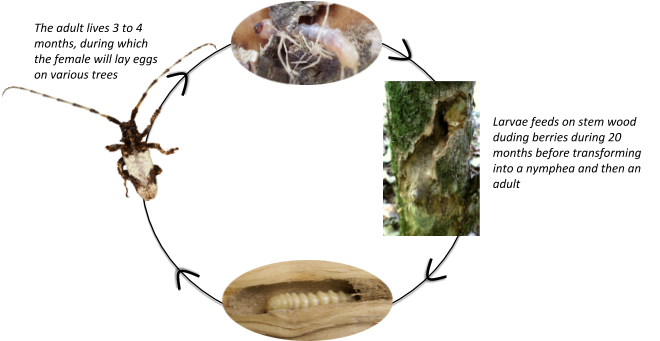
Illustration 4: Life cycle of M. leuconoteus.
African coffee white stem borer phenology is linked with temperature and rainfall patterns.
Adult emergence starts at the beginning of the main dry season, peaks one month later and ends with the first big rains at the beginning of the rainy season. However other development stages are also impacted by temperature. For example, cold temperatures might disrupt egg development, survival of larvae and result in mortality of emerged adults. On the other hand, warm temperatures are favourable for the successful completion of the pest life cycle while increasing host plant susceptibility to pest attack.
Because, the duration of the ACWSB life cycle is controlled by temperature, it varies with latitude and altitude enabling the pest to synchronize its life cycle with conducive environmental conditions.
Thus, Growers have to implement control measures during the post‐harvest (dry) season to reduce residual infestation to low levels before the next rainy season.
ACWSB Control:
Integrated pest management (IPM): it is currently the method of control advocated by many coffee research institutes, producer associations, development cooperation centres and some government authorities.
IPM consists of several methods of control applied together, including:
Prevention:
Monitoring:
Mostly by visual inspection as there is no available traps at the moment. Look for wood shavings at the base of the trees to spot larvae. Adults can be seen in the morning, warming up on the sunny exposed part of the trees.
Direct action:
Antestia Bugs are small bugs about 5mm long feeding on the green organs of coffee, Arabica and Robusta. It is responsible for altering the quality of the beans, giving them a “potato taste” that will lead to the rejection of the production by the buyer.
Antestia Bugs are circular in shape and very variable in colour; it is mostly black with yellow and white marks on the back, but it always shows three yellow spots on its back: one behind the head and two on the scale on the back. Its Latin name is Antestiopsis thunbergii; it is an Hemiptera of the Pentatomidae family.
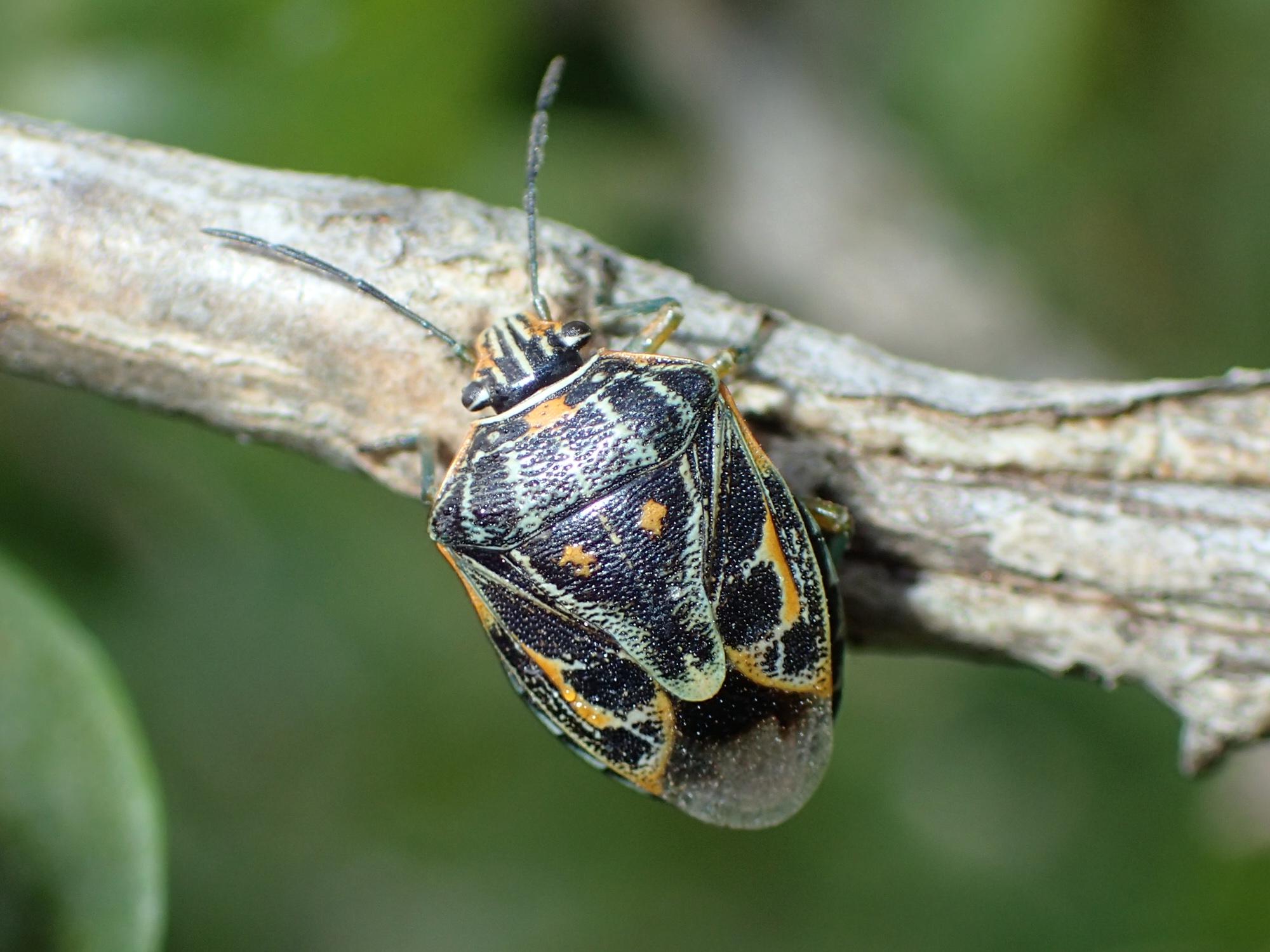 |
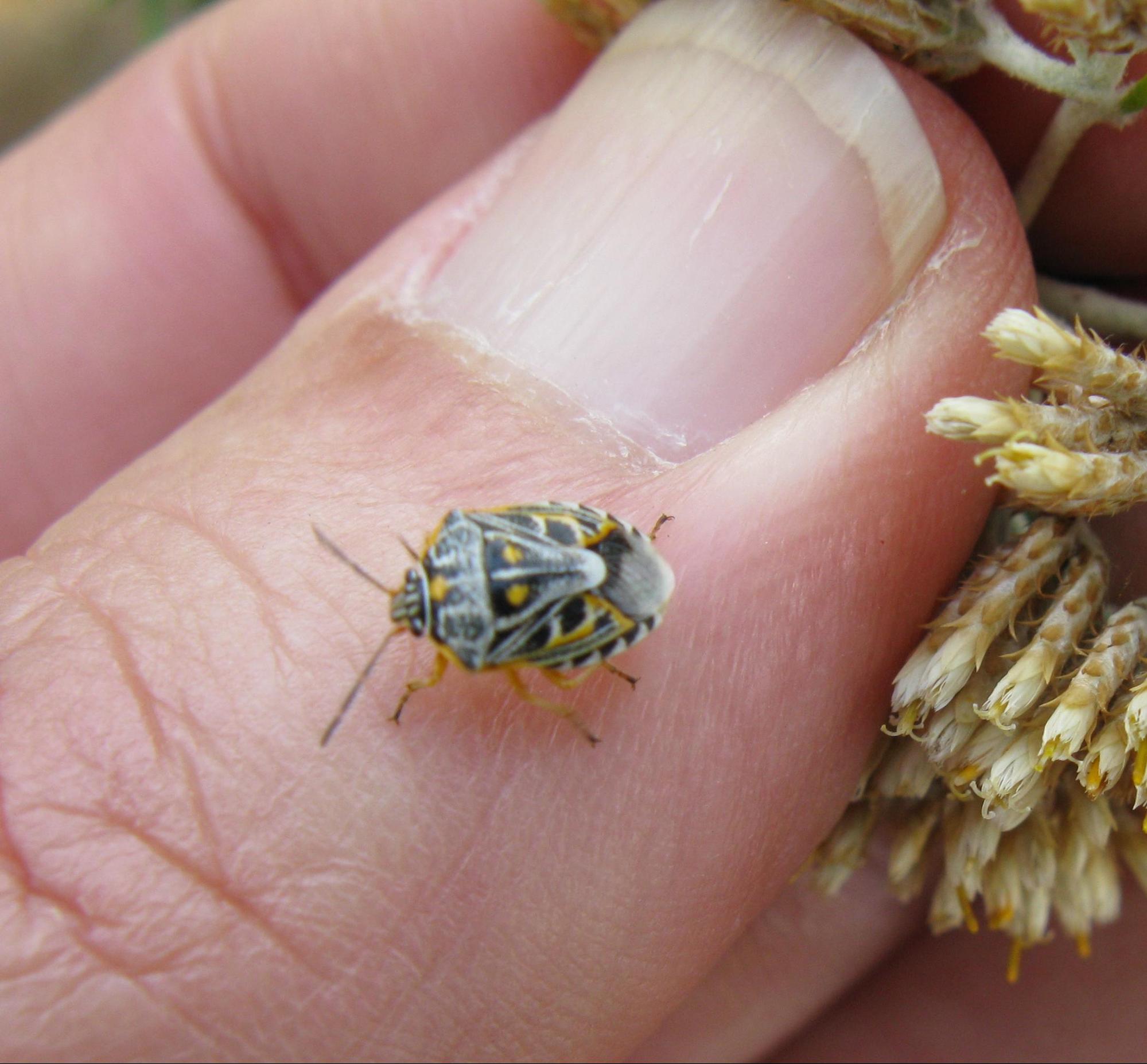 |
Illustration 1: Antestiopsis thunbergii adult stage - Notice the three yellow spots, one behind the head and two on the back.
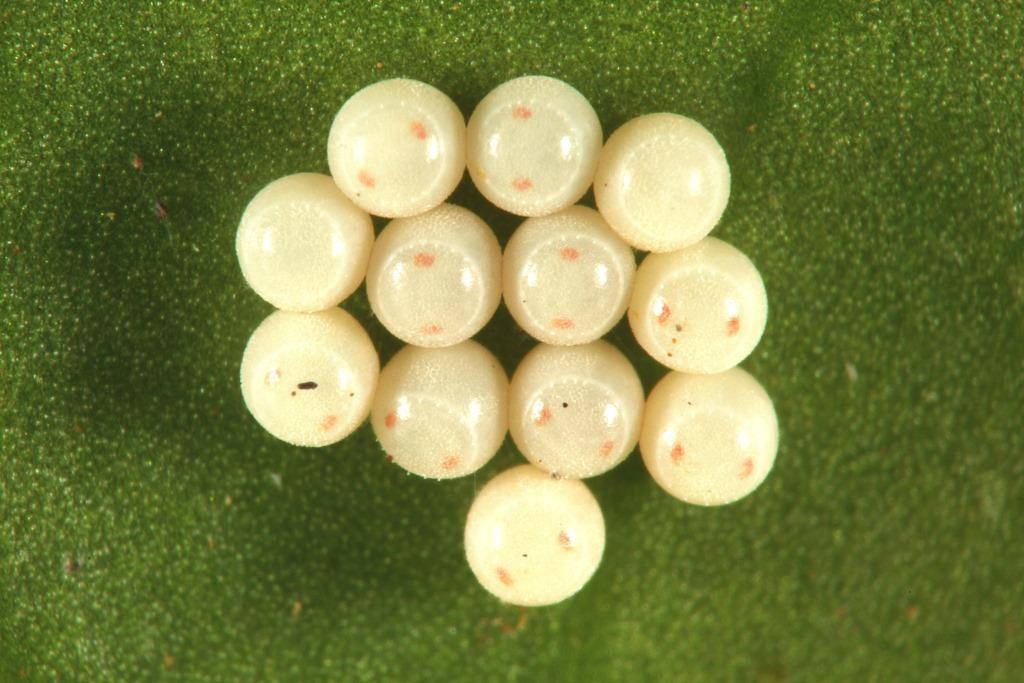 |
 |
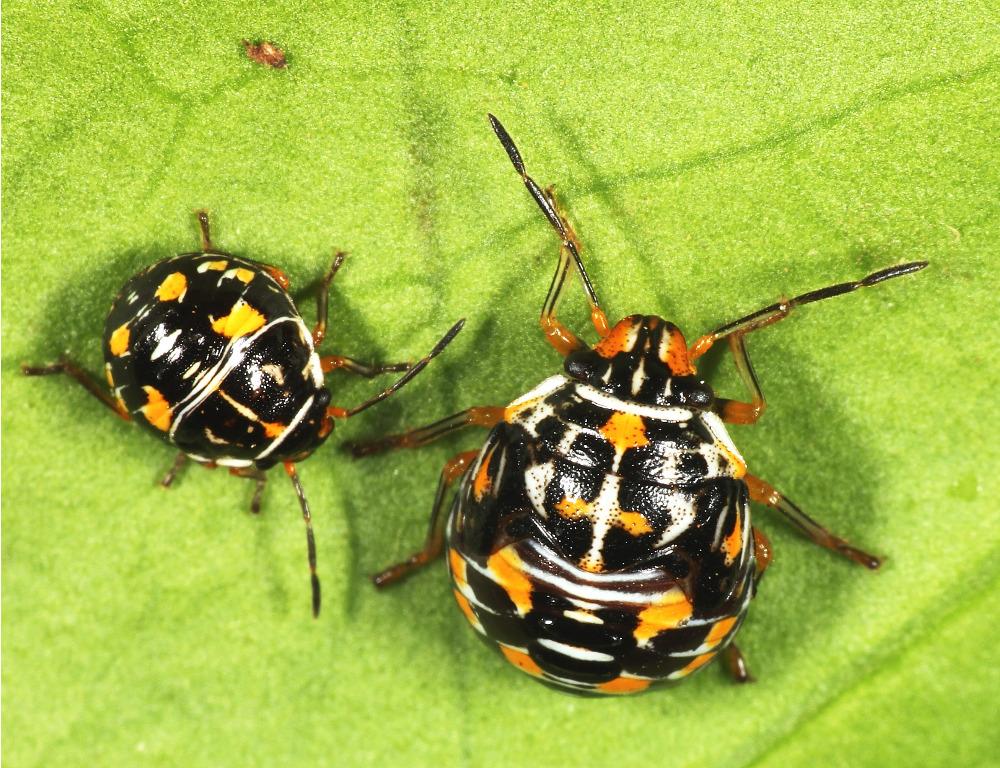 |
Illustration 2: Antestiopsis thunbergii eggs, nymph stage 1 and 5.
Symptoms:
The pest feeds on coffee leaves, buds, flowers and berries leading to direct damage. The insect pierces the different organs and the resulting holes become potential entry points for various pathogens. For example, feeding lesions allow the fungi Nematospora sp. to colonise the beans, leading to endosperm rotting and a damage known as “zebra beans”.
Antestiopsis thunbergii is also supposedly involved in the transmission of a bacteria Pantoea coffeiphila (Enterobacteriaceae), causing a flavour defect of coffee beverage known as ‘potato taste’ defect (PTD), which threatens coffee production in the African Great Lakes region.
In addition, by feeding on immature berries, the bug causes premature fruit fall and necrosis of the beans.
Life cycle and environmental variables:
Adults live about three months and females are able to lay about 160 eggs. Eggs are laid under leaves and hatch in 5-6 days during the dry season and in 8-10 days during the rainy one when the temperatures are lower. They are five nymphal stages lasting about 45 days during the dry season and about 90 during the rainy season. Both nymphs and adults are mobile and circulate on the plant, however only adults can fly from plant to plant. They are also both responsible of damages as they all feed on the plant.
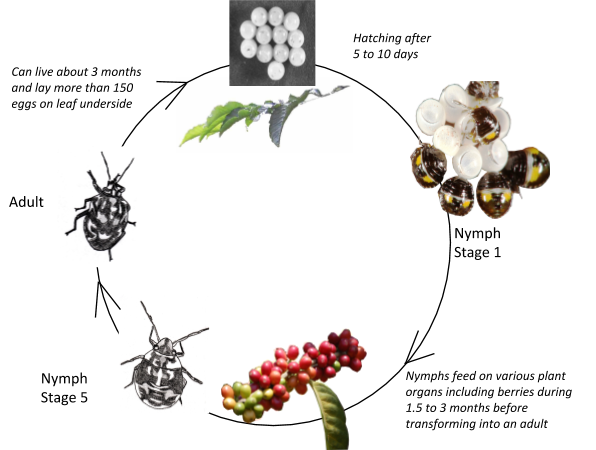
Temperature is the most important environmental factor that affects insect development and distribution, and it is highly correlated with elevation. Variation in temperature affects insect population dynamics through insect physiology and behaviour. Indirect effects are also expected due to the impact of temperature on host plants and natural enemies.
Contrary to most other coffee pests, like the Coffee Berry Borer (CBB), A. thunbergii appreciates cool temperature and thrives in high elevation areas. The pest is present in Arabica coffee farms between 1000 and 2100 m asl, with a strong preference for plantations at the highest elevations.
Two closely related Antestia species, A. intricata and A. facetoides, are more common in coffee plantations at low-medium elevation (1000–1600 m asl).
Control:
Integrated pest management (IPM): it is currently the method of control advocated by many coffee research institutes, producer associations, development cooperation centres and government authorities.
IPM consist of several methods of control applied together, including:
Prevention:
Monitoring:
It is very important to noticed that the economic threshold for acting against this pest is as low as there are either one or two bugs per coffee tree on average.
Direct action:
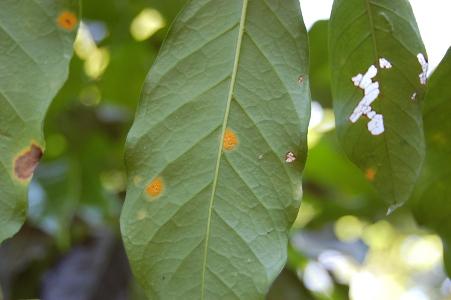 |
 |
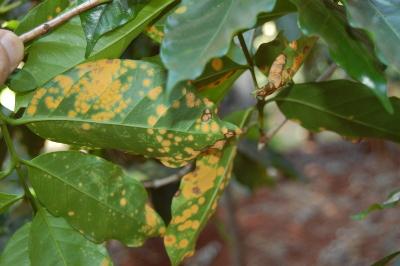 |
 |
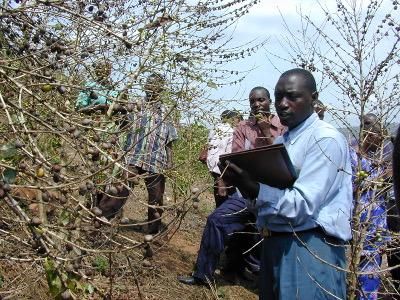
Coffee Leaf Rust (CLR) is caused by a fungus, Hemileia vastatrix, which is distributed worldwide. It is a major cause of damages to Arabica and Robusta coffee although the later may express some level of natural resistance depending on its genetic background.
Symptoms:
CLR mostly infects mature coffee leaves, while young and developing ones are seldom contaminated.
Characteristic symptom of the disease is the development of powdery orange patches on the leaf underside caused by the emergence of H. vastatrix minute fruiting bodies (the spores). On the leaf upper side, patches are not bearing spores and appear as chlorotic spots.
Under warm and humid conditions, patches expand from few millimetres to 2 to 3 cm in diameter. During expansion, the central part of the patch becomes progressively necrotic while spores continue to be produced on the patch border.
When favourable conditions last long enough, individual CLR spots will eventually merge together, leading to the necrosis of as much as 20% to 30% of the leaf area. At that stage of infection, leaves may shed from the branch, and in case of severe continuous attack of CLR, total tree defoliation can be obtained, leading to the progressive exhaustion of the tree and eventually its death.
Weather variables favouring CLR epidemics:
Although many factors control the development of CLR epidemic (soil conditions, farming practices, etc.), the main ones are weather variables such as temperature, humidity and rain.
For these reasons, CLR epidemics are mostly seen in lowland areas (below 1500m altitude) in rather warm conditions. They are rarely seen at higher altitude, where temperature is too low for the growth of H. vastatrix. Epidemics are favoured by moderate and discontinuous rainy seasons, while their extension is reduced under heavy and continuous rain conditions. Epidemic development may further continue during the dry season, when dew is sufficient to ensure H. vastatrix multiplication.
CLR control:
CLR control is complex as epidemics are controlled by various interacting factors (environment, practices, genetic), which make every location as unique, requiring specific and adapted measures to limit the spread of the disease.
Nevertheless, monitoring and controlling the disease is necessary if one wants to reduce the risk of important production loss and, in some cases, the destruction of the crop by exhaustion.
Genetic control of CLR is a valuable option as it is efficient to reduce the impact of the disease at low cost. However, two important constraints may limit the adoption and implementation of the technique: (i) varieties resistant to rust adapted to your region may not be available and (ii) H. vastatrix has the capacity to evolve and to overcome the resistance expressed by coffee varieties. In both cases, genetic control will be impossible or inefficient. So, before initiating such activity on your farm, we recommend that you seek advice from coffee authorities of your region who will guide you on the best control strategy.
Chemical control has been proven efficient to prevent or contain CLR epidemic below the economic threshold, but it is costly in terms of time and money and is usually regulated. Therefore, before embarking in the activity, it is recommended:
(i) to check the national regulation on chemical application on coffee: which chemicals are authorized, under which conditions, and which one are not, this to ensure the legality of what you are intending to do on your farm;
(ii) to confirm that you are not going against the production standards you want to implement; Your farm may operate under a certification scheme that does not allow the use of certain chemicals. Confirm that the one you are intending to use is authorized, if you don’t want to put your certification at risk;
(iii) to make sure that the chemical you want to apply is available in your region, that supply is sustained, and that the price is affordable, this to help you evaluate the sustainability of your action.
Once all these are checked, you may want to initiate chemical control of CLR in your farm.
Usual recommendations mostly rely on copper utilization in the form of copper oxychloride in wet powder (WP) formulation, to be applied every 2 to 3 weeks, as a protective measure. Dithiocarbamate can be alternated with copper application if one wants to reduce copper accumulation in the soil of the plot.
When possible, copper application could usefully be complemented by fungicides from the triazole or strobilurin families, which are costly but possess systemic and curative potential.
Cultural practices may offer valuable options to limit CLR impact on your production. They are all based on the same principle, which is to stimulate the growth of coffee and to generate vigorous plants, as healthy and well-growing trees will better resist CLR infection than exhausted and weak ones.
Vigour depends on many factors including the variety you are growing, its environment (soil, weather) and the current agronomy context of your farm. It is therefore difficult to propose which practice is best adapted to your farm, which would generate the best result, but the general recommendation is to ensure good maintenance of your plot and provide adequate care to the crop for optimal growth. This includes:
For more:
 |
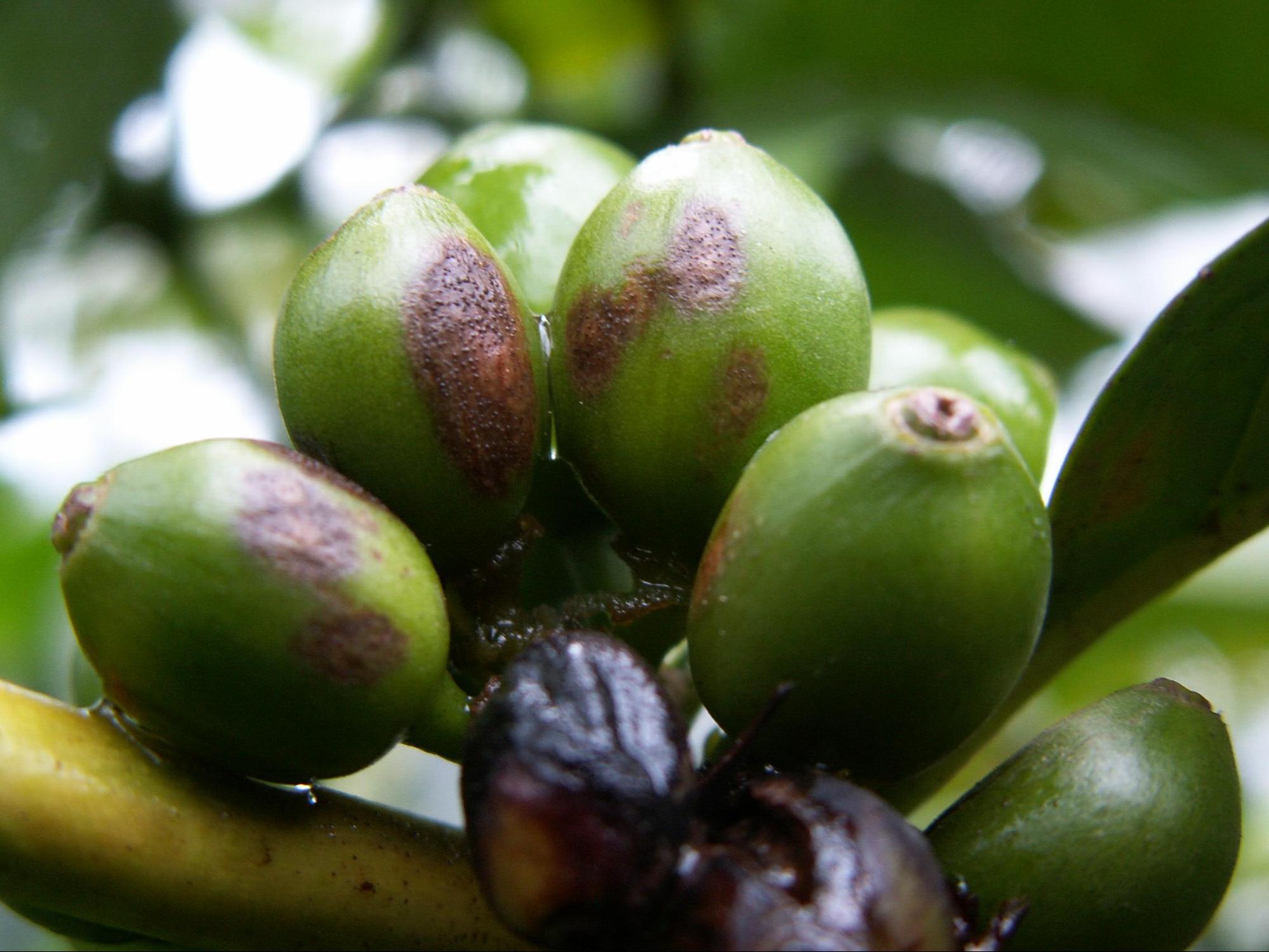 |
 |
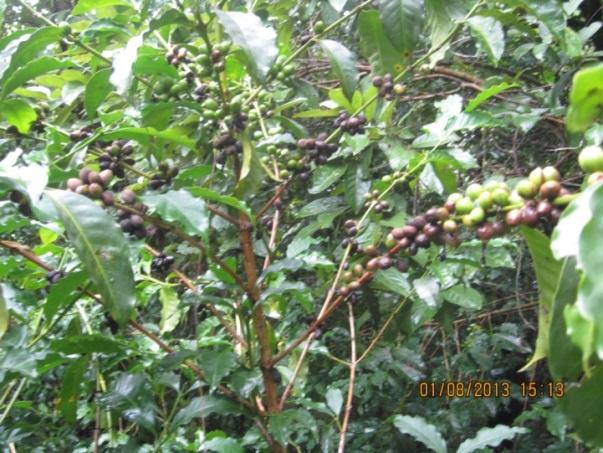 |
CBD is caused by a fungus, Colletotrichum kahawae, that infects Arabica coffee in Africa; CBD does not infect Robusta coffee, which is resistant to it, and has never been observed in America (Southern and Central) nor in Asia.
Considered as serious, CBD can cause important damages to the crop, eventually leading to the total loss of production.
Symptoms:
The characteristic symptom of CBD is a black, necrotic lesion developing on the berry skin.
The lesion first appears on young and expanding berries which are susceptible to the disease, while maturing berries progressively become resistant to infection.
Initially small in size, the lesion can rapidly expand on and inside the berry causing rot and tissue destruction. If the stalks are infected at an early stage, berries may fall off the branch while still green; remaining ones on the branches turn black and shrink as the inner tissue rots.
By the end of the rainy season, dried infected berries will stay attached for several weeks to the branch as mummified berries.
Weather variables favouring CBD epidemics:
According to these characteristics, CBD epidemics are seen only in regions where berries mature during the rainy season, when frequent and heavy rains combine to rather cool temperature therefore generating humid and wet conditions favourable for C. kahawae development.
CBD control:
CBD is difficult to control but efforts should still be made to limit its development during heavy or long rainy season as it may cause the loss of the whole farm coffee production.
Genetic control: The easiest and cheapest solution is to plant coffee varieties that are genetically resistant to the disease. CBD occurrence and spread will then be prevented whatever climate conditions occur in your region.
When resistant varieties are not available other measures can be taken to limit CBD impact.
Chemical control has been proven efficient to contain CBD epidemic below the economic threshold, but it is costly in time and money and is usually regulated. Therefore, before embarking on the activity, it is recommended:
(i) to check the national regulation applying to chemical application on coffee: which chemicals are authorized, under which conditions, and which one are not, this to ensure the legality of what you intend to do on your farm;
(ii) to confirm that you are not going against the production standards you want to implement; Your farm may operate under a certification scheme that does not allow the use of certain chemicals. Confirm that the one you are intending to use is authorized, if you don’t want to put your certification at risk.
(iii) to make sure that the chemical you want to apply is available in your region, that supply is sustained, and that the price is affordable, this to help you evaluate the sustainability of your action.
Once all these are checked, you may want to initiate chemical control of CBD in your farm.
Usual recommendation mostly relies on copper utilization in the form of copper oxychloride in wet powder (WP) formulation, to be applied at the concentration of 50 grams in 20 litres of water. As the rains will progressively wash away the applied powder, it is necessary to renew the application quite frequently: one treatment every 10 to 14 days in case of heavy rain, to one treatment per month in case of relative dryness.
Cultural practices are an interesting alternative to chemical control as they cost much less and are environmentally friendly. They are always recommended if your farm is certified (Fair Trade, Organic, etc.).
Considering that high humidity conditions favour CBD development and that ageing coffee bushes are usually more infected than young ones – this is due to repeated self-contaminations - the following measures may be recommended:
For more:
During the last decades, the general objective, world wide, has been to increase coffee production and productivity through the promotion of sun-grown coffee. This is achievable at the cost of two major constraints:
For increased sustainability, two options can be considered based on the adoption of agroforestry and intercropping practices.
Combining coffee and tree has several advantages:
 |
|
 |
Trees are also “windbreakers”, quite useful as coffee is highly sensitive to wind. |
How to manage coffee agroforest?
 |
Shading should not exceed 40% Shade trees should be pruned to limit competition with coffee trees at the beginning of the rainy season |
 |
Several species should be associated: Leaves of different species bring different nutrients and decompose at different speeds. Trees that have different uses can be used: lumber - fruit trees. Competition can be reduced if :Trees recycle minerals better; their roots go deeper, while coffee and banana roots are close to the surface. |
Which tree can be used in association with coffee?
 |
Rapid growth, with large and high canopy; Deep rooting system to limit competition for water or nutrients; Ability to fix nitrogen from the air; Deciduous tree; rapid leave decomposition; short shedding period; Easy to prune. |
When is agroforestry not a good option?
Intercropping is an interesting option as it helps to protect the soil and offers income diversification solutions.
 |
Banana can be permanently cropped with coffee assuming that the planting pattern avoids competition. Sufficient space should be kept between the two species. |
 |
Other crops can be installed between coffee rows, such as beans, soybeans, tomatoes, as they reduce erosion, contribute to weed control and add an extra income This can be done only when coffee is young, less than 2 to 3 years old; after this stage, the cash crop will compete with coffee and reduce the production. |
Intercropping is an interesting option as it helps to protect the soil and offers income diversification solutions.
 |
 |
| inter row ridges... | … with stabilizing plants |
 |
 |
When cherries are fully matured, coffee beans have the highest quality that can be expected. Harvesting in a correct manner will preserve this quality; poor or wrong harvesting will result in a loss of quality and unfortunately, a loss of income. So, what is a correct harvest?
To correctly harvest, you need a basket to collect the cherries, you need also a bag to transport them. Ideally, you should need a polyethylene sheet to cover the ground while harvesting, as mature cherries will fall on the ground and you may lose a significant part of your production if you cannot collect them once fallen. Furthermore, cherries collected from the ground and spoiled with soil may be damaged and spoiled (stinking taste).
 |
When picking, only ripe cherries should be picked, the “bright red” ones. Others, still to mature, not with the right redness, should be collected later. Therefore, there is a need for several rounds of picking. |
 |
Pick the cherries one by one, and avoid “stripping”, which will result in harvesting immature cherries |  |
Within 6 hours after picking, not more, cherries should be put to dry (kiboko) or processed at the pulping station.
The cherries that you should not pick as they will alter the quality of the green coffee:
 |
Green cherry Pulp not fully formed Difficult to pulp |
Pale beans A bitter, grassy taste Decreased cherry weight |
 |
Yellow cherry Poor growing conditions Weak or sick coffee trees |
Yellowish-coloured beans Poor quality |
 |
Overripe cherry Purple tint Beans already fermented in cherry Disappearance of mucilage |
Difficult to pulp Fruity to rotten taste |
 |
Black cherry Dried on the tree Picked up from the floor |
Unable to pulp Wood taste |
When kept too long after picking, more than 6 hours, cherries start to ferment, which is an important cause of quality alteration.
 |
Fermented cherries are black and stinking; they will produce waxy looking beans; Coffee parchment will look reddish with dirty furrow; Drink will have an over-fermented or stinking taste; Despite picking correctly, cherries with faults may have been collected as well. These need to be removed through sorting the harvest before drying or processing the cherries. Not removing damaged cherries will definitely alter the quality of the beans, consequently causing bad taste. |
| Faults to be eliminated | Taste (to the cup) if not removed. |
| Green, yellow (immature) cherries because they give black beans | Green |
| Dark red, brown, black and parched cherries; over-ripe | Bitter or harsh; Fermented - alcoholic |
| Black cherries, rotten, stung, stained that are not healthy | Pharmaceutical |
| Plant debris, small pebbles and other seeds | Earthy or Dusty |
When too many immature or damaged cherries have been harvested, removing them before processing is required if one wants to obtain an acceptable level of quality.
 |
 |
When the harvest is over, it is important to remove the remaining berries, the leftovers, as they can be the host of pests (Coffee Berry Borer -CBB) and disease (Coffee Berry Disease -CBD). If left on the trees, they will ensure their survival during the inter-cropping season, leading to a higher level of infections on the following crop, hence greater loss.
 |
Pick up the damaged, rotten, black and dried cherries that are left on the trees or fallen to the ground. Harvest all overripe cherries |
 |
Take the infested cherries out of the coffee plantation and throw them into the fire or drown them in a water container to kill the borers |
Copyright © 2022 (v2.1.0)